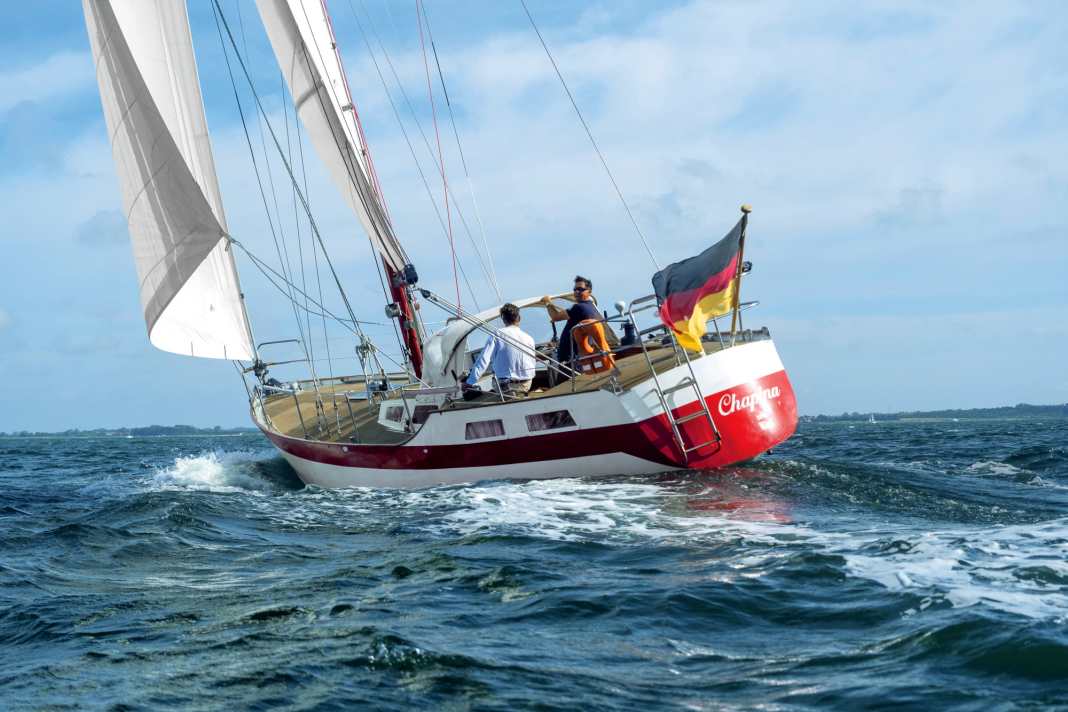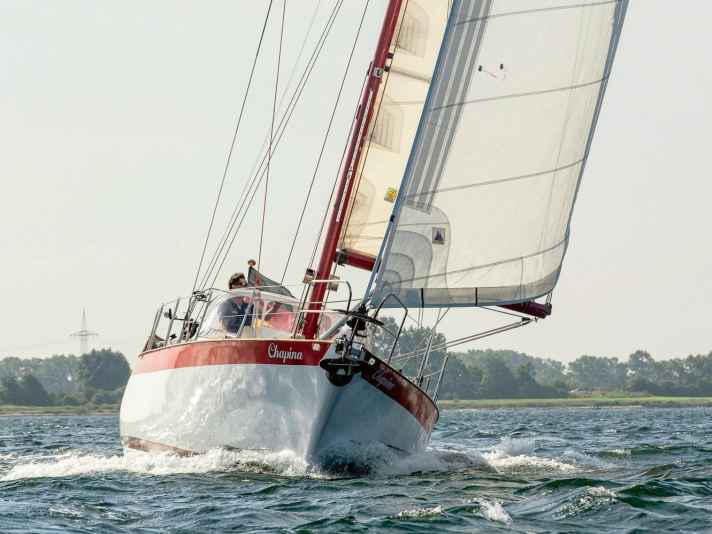"Chapina": 40-foot ocean-going yacht makes it from the sandpit to the Atlantic
Lasse Johannsen
· 23.03.2025






Summer 1992, in the Kattegat. The stiff westerly wind has turned the journey from Marstrand to Skagen into a long, tedious bumpy ride. The day is over before a harbour comes into sight. In the darkness, skipper Sven Klingenberg notices a glow of light that makes the crests of the waves glow white. Through the glass, he recognises a Danish naval vessel, calls it on the radio and asks what is going on. The answer electrifies the 25-year-old: The soldiers are searching for a floating sea mine. And the "Chapina", on which the young man and his crew are on holiday, is made of magnetic steel, which could set off the detonator.
Other special boats:
But the event turned out well. His 40-foot yacht is still afloat today, and Klingenberg can laugh out loud when he tells his guests about this experience during a visit on board. Of course, this is not the only anecdote from his life on this ship. He tells of a childhood on the water, of growing up with responsibility and adventures between the Kattegat and the Caribbean. And at the centre of it all: the "Chapina" - because Klingenberg has been sailing on her since his father built her himself 50 years ago according to plans he drew himself.
"Chapina" will be built in one year
The story begins in 1975, when Sven Klingenberg was nine years old and amazed as the hot-dip galvanised steel frames were first erected upside down and then planked with the 60 x 40 centimetre, three millimetre thick steel plates that his father had hammered into shape in the sandpit. The enthusiast builds the entire ship, including the interior, in front of his eyes in just one year. And he does this after work, because the shipbuilding engineer works as a certifier for Germanischer Lloyd.
When the "Chapina" was handed over to her element in the summer of 1976 and moved into her first berth in Kiel-Schilksee, she was the largest ship in the entire harbour. The club chairman says "Kümo" dryly to the steel colossus, but any mockery is soon silenced, because the 40-footer is well constructed, weighs only nine tonnes and sails away from many from day one.
Ten years ago, the builder set off on his last voyage without his ship. But his son Sven continues to look after and sail the "Chapina". In Heiligenhafen, her current home port, he sits in the cockpit and serves strong black tea. A tradition that, like so much else here, comes from his father, who came from East Frisia.
The hull length of 40 feet was symbolic for the builder. Sven Klingenberg remembers: "Son, when you grow up, we'll sail across the Atlantic," his father encouraged him as he worked, explaining that the waves there are 120 feet long from mountain to mountain and that a third of that was the perfect size for the project.
Resourceful solutions have been proving their worth for 50 years
This was not the only idea that father Klingenberg had at the time. A contemporary cruising yacht with a centre cockpit and medium-length keel was created on the drawing board. The design of the lateral plan was inspired by the Sparkman & Stephens cracks of the early 1970s. And for numerous details, the designer draws on solutions that proved successful in his first self-build and on his professional experience as a shipbuilder.
He is also clever when it comes to the economic realisation of his dream. Father Klingenberg simply took the heart of the drive, a Mercedes OM 636, from his company car. After 300,000 kilometres, the engine had done enough back then, and it still works reliably on the "Chapina" today. And there is no gearbox that could break down. The engine drives the shaft at an adjustable speed, at the end of which a controllable pitch propeller ensures forward or reverse travel.
There is also no heat exchanger. The "oil engine" is cooled with 60 litres of liquid, which is pumped in a circuit through channels in the skeg, which is surrounded by seawater. The diesel tank is a compartment at the rear of the keel, the tank for 400 litres of fresh water is part of the stem at waterline level as a crash box.
The "Chapina" is steered using a tiller, which moves the quadrant located far behind the cockpit via a linkage. The ship can be craned using a hot harness, which is guided through an opening on deck and attached directly to the keel.
"Chapina" fulfils its purpose as an ocean-going yacht
The shipbuilding engineer benefits from his professional contacts during construction. "My father installed a lot of things here that he developed for shipyards," says Sven Klingenberg. In 1975, blocks and fittings for 40-foot yachts were not available on the shelves of the suppliers and had to be made individually. Klingenberg does this in co-operation with the training workshops of the shipyards where he goes in and out. Sven Klingenberg still remembers well how his father moulded the steel plates in the sandpit and tacked them to the hull before a welder finally attached them. The senior pours the lead ballast into the keel himself.
The tinkerer is also inventive when it comes to the rest of the equipment. The bow and stern pulpit are made from old pressurised pipes. He even welded the anchor together himself and modified the design until the iron dug in properly when he tried to tow the boat by car on the beach. And when the extension work began in early 1976, the then nine-year-old Sven was even allowed to lend a hand. "And then, in the spring of 1976, the ship was christened and during the holidays we went straight on tour up to Sweden and Norway."
After graduating from high school, his father entrusted him with the "Chapina" as skipper. From then on, they took turns on summer trips, thereby expanding their radius. One day, he also realises his dream of sailing the Atlantic: In September 1994, Sven Klingenberg boarded in Lisbon, where his father had transferred the "Chapina". With changing crews, he sailed to the Canary Islands and reached the Caribbean with the ARC, where the ship remained for two seasons and was sailed alternately by father and son before they sailed it back, again in rotation, and moored it again in Kiel-Schilksee in July 1996.
Technical refit after 30 years
There have never been any major fundamental changes on board the "Chapina". The self-built boat has stood the test of time as it was launched. Its characteristic appearance is characterised by striking lines, a bow with an implied clipper stem, the tumblehome hull, the open deck area, the small superstructure and the deep cockpit behind it, the enormous poop deck and the striking red stripe on the hull. The yacht can also be recognised from afar by its bright red mast, which has always been the same as it is today.
In 2008, father and son decided to manage the ship as a joint ownership from then on. For Sven, it was the right time to carry out a refit and implement various innovations. After excursions into the maxi yacht scene, he had learned to appreciate their equipment standards and developed the ambition to modernise the "Chapina" accordingly.
Below deck, the panelling and on-board electronics are renewed, a bow thruster and an electric anchor winch are installed on board, as well as other components for greater comfort such as a refrigerator, water boiler, outdoor shower and a permanently installed autopilot. The hull is fitted with a stainless steel coaming to prevent rust from forming under the wooden gunwale, which has sometimes led to unsightly streaks on the outer skin.
Generation change on the "Chapina"
"We were at the shipyard seven days a week for a quarter of a year until my father complained that he felt like a labourer," Klingenberg remembers, laughing, and says that since then he has known that a ship will never be finished. "I then drew up a list with the outstanding points and ended up with 18 pages, in small print." Since then, he has been working through the list as time and budget allow, but new items are always being added.
Father Klingenberg sailed the "Chapina" for a few more years with his wife or friends and took turns with his son along the way, then he retired from sailing and transferred his remaining share of the much-loved ship to his son.
Since then, Sven Klingenberg has been sailing with friends or single-handed on the Baltic Sea. Once again, during the coronavirus pandemic, he is seized by enthusiasm and embarks on a comprehensive overhaul of the hull. In spring 2020, the underwater hull is sandblasted and coated with a mixture of zinc dust and epoxy resin.
The ship wants more
In Heiligenhafen, despite the sun, you can tell that summer is coming to an end. There is a fresh breeze and the air is cool as the Chapina moves out of the box to the sonorous hum of her "oil engine". It only took a few minutes to get her ready for sea and bring her under sail behind the harbour exit. On the mast, two halyard winches, of course of our own design, have been doing their job reliably for 50 years, the foresail is unfurled via a Furlex and immediately pulls the ship with force.
The cruising mode is already established. In the deep cockpit, the crew sits protected and close to the centre of the ship, so that the already gentle movements are muted. The helmsman, tiller in hand, looks forward over the open deck. While nine tonnes of steel push powerfully through the sea beneath him, he can easily keep the softly dipping ship on course from the palm of his hand. It's easy to imagine that it could go straight ahead for days now. Towards more distant destinations. The fact that the "Chapina" was conceived, designed and built for this purpose, that it has already proven itself on the Atlantic, is immediately noticeable under sail.
The owner makes no secret of the fact that he still has plans for her. "When we came back from the Atlantic voyage, the 'Kieler Nachrichten' newspaper was also on board for an interview. And I said that if you live on this blue planet, you should have circumnavigated it once. And the 'Chapina' is an ocean-going ship by design. She actually wants more," says Sven Klingenberg, looking into the sails with satisfaction.
Technical data of the 40-foot ocean-going yacht "Chapina

- Construction: Dietmar Klingenberg
- Shipyard: Self-build
- Material: Steel, ST37
- Torso length: 12,00 m
- Waterline length: 9,14 m
- Width: 3,43 m
- Depth: 1,80 m
- Mast height above WL: 15,00 m
- Weight: 9,00 t
- Ballast/proportion: 2,5 t/27,78 %
- Mainsail: 29,00 m²
- Fock: 38,00 m²
- Genoa: 60,50 m²
- Motor: Mercedes OM 636

